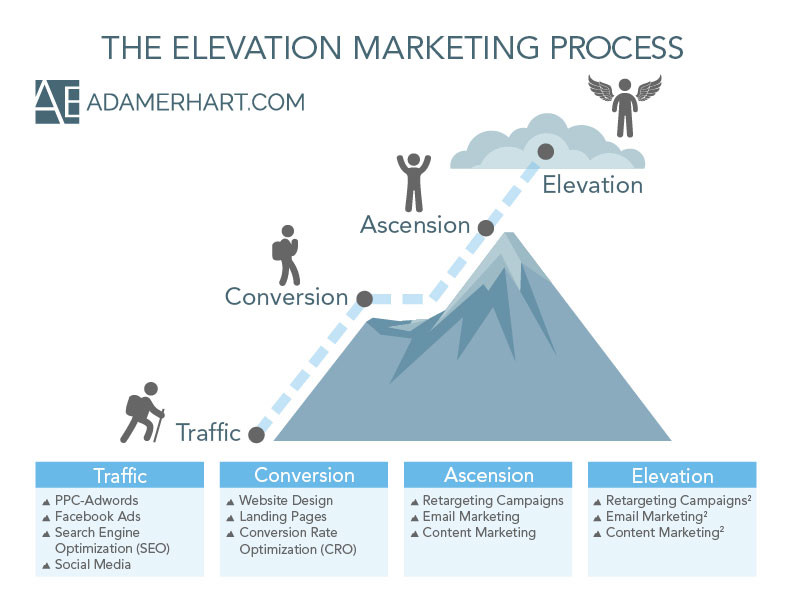Marketing Funnels. They’re one of the hottest topics in the world of business and marketing right now and for good reason.
But what exactly is a marketing funnel, and more importantly, how can you harness the power of this incredible tool in your business to generate more leads and sales?
A marketing funnel (used somewhat interchangeably with sales funnel, conversion funnel, or just plain old funnel) is a system that allows you to track the customer journey from having no idea who you are right through to becoming a lifelong loyal customer, and every step in-between.
The beauty of the funnel is that it provides a graphical representation of what can often be a hard subject to visualize.
The fact that a marketing funnel is also usually shaped like (spoiler alert) a funnel helps too.
As it’s easy to visualize that as your customers go through their journey with your brand and business you’re going to have fewer that end up reaching the progressively lower (and presumably more expensive) levels of your businesses offers, products, or services.
Create Your Own Funnel
The way to create your own marketing funnel can be as simple as taking a look at your business and how you acquire customers.
What are the stages a prospective customer takes and the journey they go through that moves them from having no idea your business existed to becoming a loyal customer.
The Modern Marketing Funnel
My suggestion is to use something along the lines of The Modern Marketing Funnel which goes: Traffic – Conversion – Ascension – Evangelism
- Traffic
Step 1 is to identify where your prospective customers (let’s call them leads) are coming from. Are they finding you through social media, a search engine, or a paid ad you’re running. Once you’ve identified your traffic sources you can start to compare and pit them against one another. May the strongest traffic source win!
Leads who have never heard about you or your business before are called “cold”
- Conversion
Once your lead has arrived at your website, store front, or landing page, the next step is to get them to make a micro-commitment and take some form of action.
If you’re selling a low priced item (like a pack of gum) than that action could be a sale.
If you’re selling a higher priced item (like a car) than that micro-commitment could be a smaller action (like going for a test drive).
The point here is that you want to encourage them to take the next logical step in the relationship, whether it’s exchanging their contact information (name, email, phone number, etc) or even agreeing to a follow up meeting.
Your lead is now “warm”
- Ascension
Alright, at this point in the funnel you’re going to be working with fewer leads than you started with.
But that’s ok!
Because those that are still with you are a higher quality lead, and are more interested in what you have to offer.
They’ve also taken some form of action or micro-commitment and are a lot more open to what you have to offer next. It’s at this stage that you want to begin the follow-up process and really bring the value.
Continue to nurture your leads by providing more valuable and helpful information but at the same time, don’t be afraid to ask for the sale.
If you’ve done a good job at guiding them along their journey up until this point the next logical step should be your core offer, product, or service.
When your “warm” lead buys and exchanges their money for your product or service they become “hot”
- Elevation
It’s now time to really bring on the value.
Following up with your recent buyers is one of the fastest ways to solidify your position as a business that truly cares.
Buyers remorse is very real, and is alive and well across all markets and industries, so the first 24-48 hours after making a purchase is a critical time to calm any anxieties and affirm your new customers decision to do business with your company.
It’s also unexpected.
Which makes it an even nicer surprise, and part of the system to turn customers into brand evangelists who tell their friends, family, coworkers, and sometimes even strangers, about just how great your business is.
The Power Of The Funnel
Here’s where things get good…
Now that you know what a marketing funnel is, and you have the framework to create your own, it’s time to start diving in and putting the pieces in place.
By creating your own funnel and outlining your businesses system (or lack thereof) for traffic, conversion, ascension, and evangelism, you’re ensuring that no marketing stone is left unturned.
This is incredibly powerful stuff as it will enable you to very quickly identify your marketing and customer journey’s strengths and weaknesses.
Are you not getting enough leads?
Then you have a traffic problem (ie poorly performing paid ads, low search engine rankings, lack of brand awareness)
Getting plenty of leads but they don’t seem to be interested in what we’re doing?
You have a conversion problem (ie poor offer, misaligned messaging, product/market mismatch)
Have people who say they love what you do, but don’t seem to buy?
You have an ascension problem (ie value communication issue, benefit misunderstanding, lack of trust)
Have people that love what you do, buy it, but then don’t tell anyone?
You have an evangelism problem (ie lack of shareability, not optimized for word of mouth, not incentivized)
The Marketing System
The beauty here is that when you lay everything out in a funnel, stuff gets real, real fast.
There’s no hiding a flawed strategy, or justifying a bad campaign.
It just is what it is.
And that’s the power of the funnel.
To quickly and visually illustrate your customers journey in order to eliminate any chokepoints or areas of friction so you can create a system that allows you to generate leads, convert them into customers, and then turn those customers into lifelong and loyal brand evangelists.
Powerful stuff.


